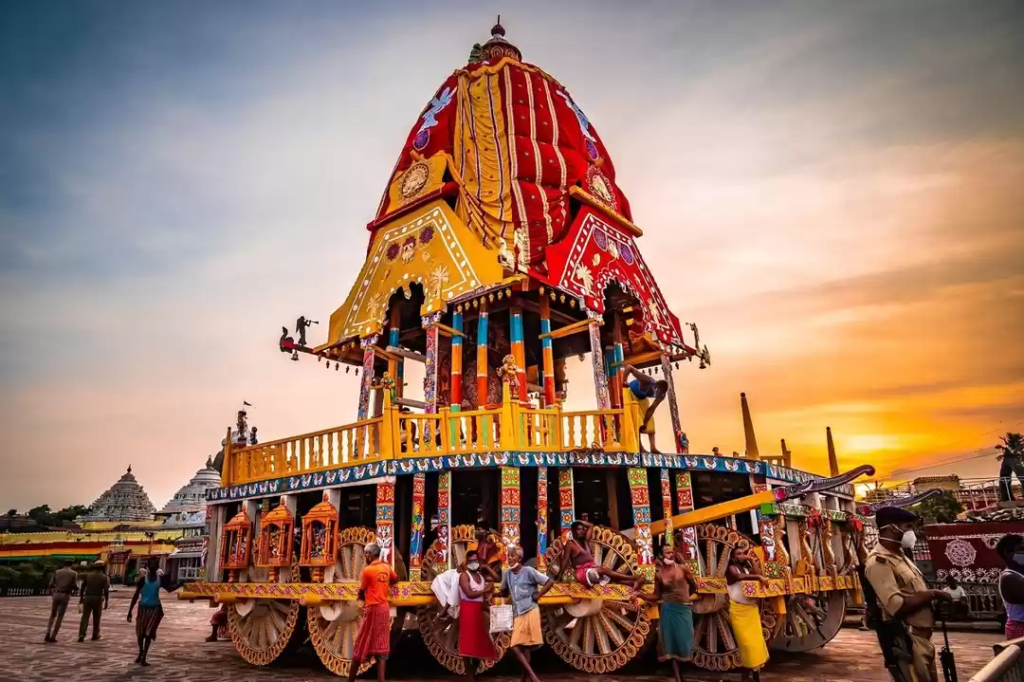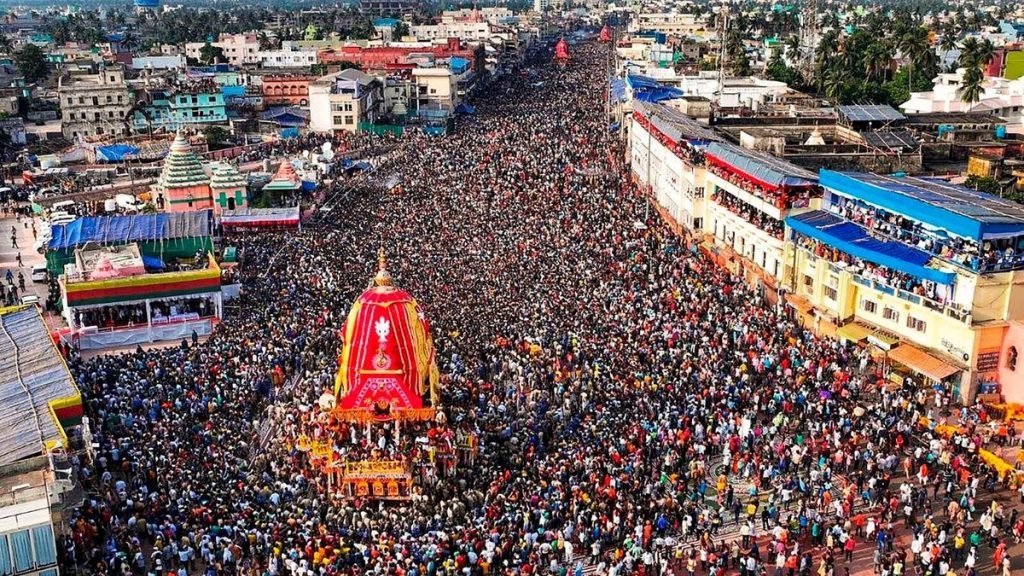
The sacred celebration of Jagannath Rath Yatra 2025 is set to fill the streets of Puri, Odisha with vibrant devotion, rhythmic chants, and the rolling wheels of colossal chariots. This year, the auspicious date of the festival is Friday, June 27. As per the Hindu Panchang, the Dwitiya Tithi—which marks the second day of the Shukla Paksha—begins at 1:24 PM on June 26 and ends at 11:19 AM on June 27. This sacred time frame is considered highly favorable for commencing the Yatra, and it is believed that taking part in or witnessing the festival during this period brings divine blessings, spiritual merit, and inner purification. Devotees from across India and the world mark this day with immense reverence and emotional anticipation.
The Timeless Origin of Rath Yatra
The origins of the Rath Yatra festival can be traced back to ancient times, long before recorded history. This Hindu festival, dedicated to Lord Jagannath, is deeply embedded in Indian mythology and is mentioned in sacred texts such as the Skanda Purana, Padma Purana, and Brahma Purana. According to legend, the devout King Indradyumna was instructed through a divine dream to establish the Jagannath Temple in Puri. Following these instructions, he built the majestic temple, making Puri one of the holiest pilgrimage destinations in India.
It is said that Lord Jagannath, who is worshipped as a form of Lord Vishnu or Lord Krishna, wished to come out of the sanctum once a year to bless those who could not enter the temple. This compassionate act became the foundation of the Rath Yatra tradition, symbolizing the Lord’s desire to be accessible to all devotees, regardless of caste, status, or origin. Over the centuries, this annual event evolved into a powerful spiritual and cultural movement.
The Divine Legends that Inspire Devotion
Several mythological stories and divine legends are associated with the Jagannath Rath Yatra, making it more than just a festival—it becomes a spiritual storytelling event. One of the most beloved legends is that of Lord Krishna longing to return to his childhood home in Vrindavan after becoming the ruler of Dwarka. In a similar expression of divine love, Lord Jagannath, accompanied by his elder brother Balabhadra and his sister Subhadra, travels to the Gundicha Temple, which is believed to represent Vrindavan or the home of his maternal aunt.
Another emotional tale tells of Goddess Lakshmi, the divine consort of Lord Jagannath, who is left behind in the main temple. When she realizes the Lord has departed without informing her, she becomes angry. Her displeasure and the eventual reconciliation are celebrated during a special ritual called Hera Panchami, observed five days into the festival. These stories breathe life into the rituals, offering devotees a personal connection with the divine emotions of the deities.
The Grand Rituals of the Rath Yatra Festival
The Jagannath Rath Yatra is renowned for its elaborate and sacred rituals. Several months before the festival, skilled artisans—often from families that have performed this duty for generations—begin constructing the massive wooden chariots from sacred neem trees. These trees are specially chosen from designated forests, following ancient guidelines. The chariots are built afresh every year and follow the specifications mentioned in temple texts.
The chariot of Lord Jagannath, known as Nandighosa, is the largest and has 16 wheels. It is beautifully decorated with yellow and red fabric. The chariot of Lord Balabhadra, called Taladhwaja, has 14 wheels and is covered with blue and red cloth. Goddess Subhadra’s chariot, Darpadalana, has 12 wheels and is adorned with black and red colors. Each chariot is a divine symbol in itself, crafted with utmost care and reverence.
One of the most iconic rituals is the Chhera Pahanra, a gesture of humility and devotion. In this ceremony, the King of Puri, regardless of his royal status, steps down to sweep the chariot platforms with a golden broom. This act symbolizes that in front of God, all are equal. It sends a profound message of service, humility, and spiritual equality. The moment the deities are brought out from the sanctum to their respective chariots is known as Pahandi Bije, and it is an emotionally charged spectacle. The deities sway from side to side, as if dancing, while devotees chant and shower flowers on them.
The Chariot Procession: A Moving Sea of Devotion
On the day of the festival, Bada Danda, the main road of Puri, becomes a spiritual river filled with chanting, singing, drumming, and tears of joy. Devotees—many of whom have traveled from far-off places—gather to pull the massive chariots with thick ropes, chanting “Jai Jagannath” in unison. This act of pulling the chariots is not just a ritual—it is a sacred duty. It is believed that those who pull the ropes receive divine blessings, have their sins washed away, and gain spiritual merit.
The chariots travel a distance of nearly 3 kilometers to the Gundicha Temple, where the deities rest for nine days. During this time, the temple is beautifully decorated and hosts various rituals and cultural performances. On the tenth day, the deities return to their original abode in the Bahuda Yatra, which is just as grand and spiritually uplifting as the outward journey. On their way back, the deities stop at the Mausima Temple, where they are offered a special sweet dish called Poda Pitha, considered one of Lord Jagannath’s favorite foods.
The Spiritual Meaning Behind the Festival
The Jagannath Rath Yatra is deeply symbolic and carries profound spiritual significance. The journey of the deities is seen as a metaphor for the soul’s journey through the cycle of life, detachment, and eventual reunion with the divine. It is a celebration of movement, transition, and the constant motion of life. The Lord stepping out of the temple signifies that God is not confined to sanctums and is always ready to walk among his people, offering them love, guidance, and blessings.
The ropes used to pull the chariots are called “Moksha Rassi,” meaning the ropes of salvation. By touching or pulling them, devotees feel spiritually elevated. Even the King, who performs the Chhera Pahanra, teaches that no matter one’s rank or wealth, everyone is a servant of the Lord. This concept of equality and service is what makes Rath Yatra a truly unique celebration.
Global Reach: Rath Yatra Celebrated Worldwide
Though the Jagannath Rath Yatra originated in Puri, it has now become a global celebration. Thanks to the work of ISKCON (International Society for Krishna Consciousness), the festival is celebrated in cities across the world including New York, London, Sydney, Moscow, Durban, and Toronto. These events feature replica chariots, devotional music, kirtan chanting, processions, and prasadam (sanctified food) distribution.
In India too, the Rath Yatra is celebrated with grandeur in cities like Ahmedabad, where it has been observed since 1878 after a saint named Narsimhadas reportedly had a divine vision of the Lord. Today, Ahmedabad’s celebration is the second-largest after Puri and features elephants, decorated trucks, spiritual discourses, and massive public participation.
Rath Yatra as a Cultural and Social Celebration
The Jagannath Rath Yatra is not limited to being a religious ritual. It is also a cultural phenomenon, bringing together people of all ages, backgrounds, and beliefs. Local artisans contribute by making decorations, painting chariots, and preparing sweets. Folk artists perform dances, dramas, and bhajans that tell stories from Hindu epics and Jagannath culture. The celebration encourages community bonding, economic activity, and spiritual learning.
The values that the festival promotes—inclusiveness, compassion, service, and faith—are timeless. The chariots may return to the temple, but the teachings and emotional connection they spark remain in the hearts of devotees all year round.
As we prepare for Jagannath Rath Yatra 2025, we are not just marking a date on the calendar—we are getting ready for a soul-stirring, divine experience. The sight of the towering chariots, the rhythm of the drums, the joy of the crowd, and the spiritual energy that fills the air cannot be described in words—it must be felt in the heart. Whether you are in Puri or celebrating from afar, the blessings of Lord Jagannath, Balabhadra, and Subhadra will surely reach you if you open your heart with devotion.
This June 27, as the chariots roll once again through the sacred streets, let us remember the deeper message of the festival—that God is always near, that everyone is equal, and that love and devotion can unite all of humanity.

































